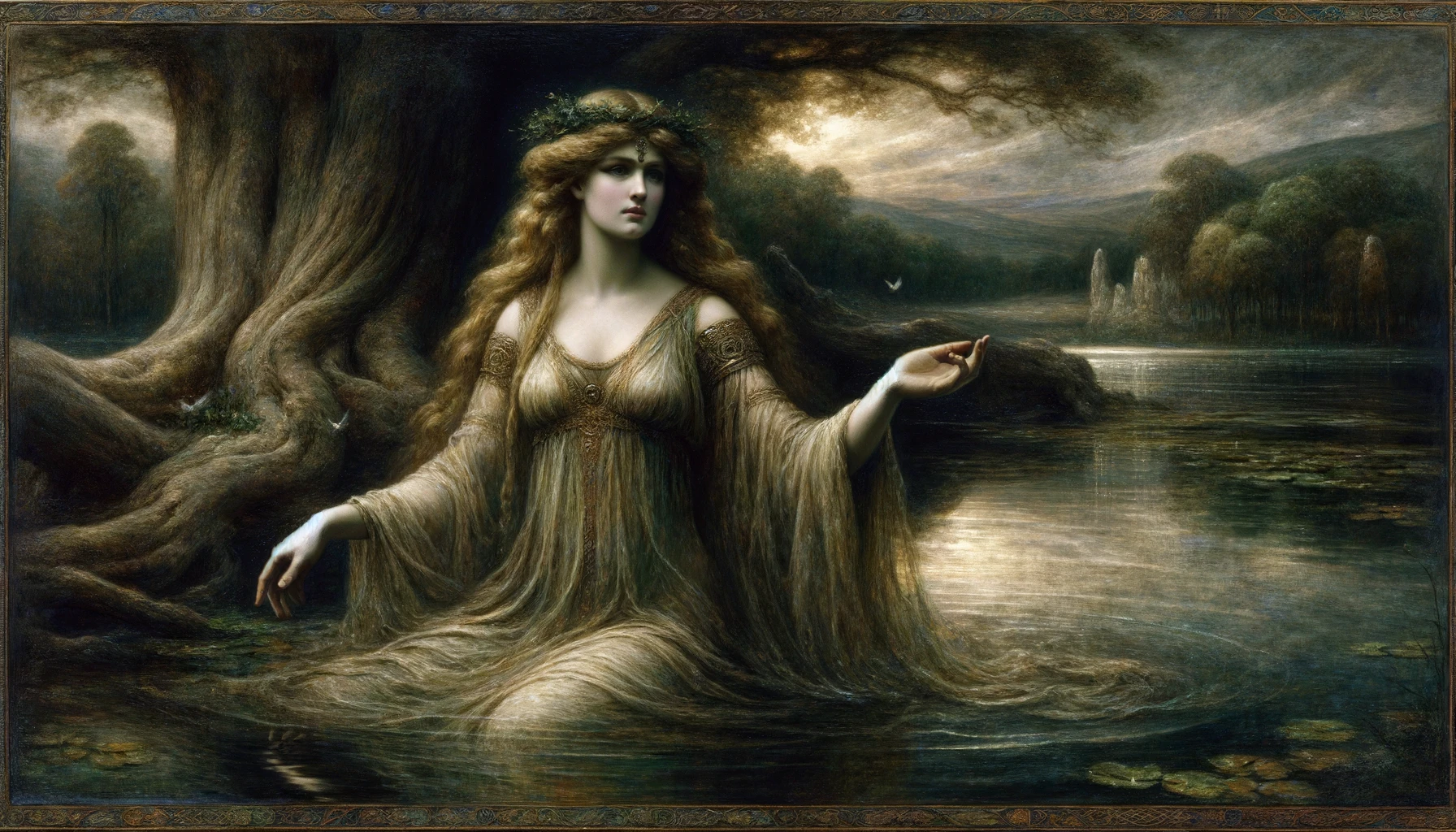The Lady of the Lake, a figure central to the Arthurian legend, manifests in various forms across medieval literature and mythology. She is portrayed as either a fairy or a fairy-like enchantress and assumes several critical roles in the narratives, most notably providing King Arthur with Excalibur, ensnaring Merlin, raising Lancelot after his father’s death, and escorting Arthur to Avalon in his final moments. This enigmatic character appears in several texts under different names and identities, sometimes concurrently, adding layers to her mystique.
The character is most commonly known as Nimue or Viviane, with variations like Nimiane, Ninianne, Vivienne, and others, appearing in different medieval manuscripts. The evolution of her name, especially in Thomas Malory’s 15th-century work “Le Morte d’Arthur,” reflects the character’s complex development over time. The name Viviane is traced to the Welsh word ‘chwyfleian,’ it is also linked to figures in Irish mythology and Welsh mythology, such as Niamh and Rhiannon.
Connections are also drawn between the Lady of the Lake and other mythical entities like the Gwragedd Annwn, the water goddess Coventina, and the Irish underworld goddess Bé Finn. Her portrayal bears similarities to other mythological figures like the Greek Thetis and the Roman Diana, suggesting possible influences and parallels.
The Lady of the Lake first appears in Chrétien de Troyes’s “Lancelot, the Knight of the Cart,” as Lancelot’s fairy guardian, a motif further explored in Ulrich von Zatzikhoven’s “Lanzelet.” Roger Sherman Loomis posited that the Lady of the Lake might have originated as one character with Morgan le Fay.
Her story’s multifaceted nature, spanning various cultural and mythological landscapes, has cemented the Lady of the Lake as a pivotal and enduring figure in Arthurian legend, embodying themes of magic, mystery, and transformation.
Tales around the Lady of the Lake
The Lady of the Lake, a prominent figure in Arthurian legend, appears in multiple forms and roles throughout the tales. In her early appearances in the 12th-century poems of Chrétien and Ulrich, she remains unnamed, later becoming more defined in the 13th-century French chivalric romance prose.
Lancelot’s guardian
As Lancelot’s fairy godmother-type foster mother, she takes over from an earlier aquatic fairy queen. However, unlike in Ulrich’s “Lanzelet,” where Lancelot is swapped with her son Mabuz, she has no children of her own in the later texts.
In the Lancelot-Grail (Vulgate) cycle, the Lady resides in an enchanted realm accessible through a lake (an illusion created by Merlin in the Post-Vulgate). She raises Lancelot after his father’s death, teaching him arts, writing, and infusing him with wisdom and courage. She also cares for his cousins Lionel and Bors, and later sends Lancelot to Arthur’s court. Throughout the Prose Lancelot, she aids him with magical gifts and encourages his relationship with Guinevere.
Merlin’s beloved and captor
The Lady of the Lake is also linked to Merlin in the Vulgate Cycle. Named Viviane, she traps Merlin after learning all his secrets, using her power to imprison him forever. In some versions, she uses this knowledge to trap Merlin under a tree or in a cave, leading to his disappearance from Arthurian narratives.
The Giver of Excalibur
In Arthurian legend, the Lady of the Lake is best known for her role as the giver of Excalibur, King Arthur’s magical sword. This iconic scene is central to the Post-Vulgate tradition of Arthurian literature. She appears as a mysterious benefactor to the young Arthur, guided to her by Merlin, and presents the magical sword Excalibur and its special scabbard to Arthur. This occurs after Arthur’s original sword is broken in a duel against King Pellinore.
The Lady of the Lake’s identity in this context is enigmatic. She is distinct from other characters like Morgan le Fay or the Damsel Huntress, and she might have connections to the Lady of Avalon (Dame d’Avalon) from the “Propheties de Merlin.” This characterization of the Lady of the Lake adds to the depth and complexity of the Arthurian narrative.
In a dramatic turn of events in the Post-Vulgate “Suite du Merlin,” this Lady of the Lake meets a tragic fate at King Arthur’s court. She is beheaded by Sir Balin due to a feud between their kin, with accusations of responsibility for the deaths of close relatives. Following this incident, her body mysteriously disappears.
These events occur while Merlin is still a prominent figure alongside Arthur, before the introduction of the young Viviane, another iteration of the Lady of the Lake character, in the same cycle of stories. In modern retellings of Arthurian legend, the episode of her killing by Balin is often omitted, and she is frequently conflated with the character of Viviane. This blending of characters and stories exemplifies the fluid nature of Arthurian legend, where characters evolve and merge over time through various iterations and adaptations of the tales.
